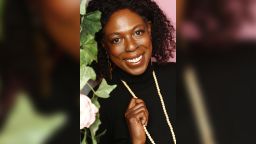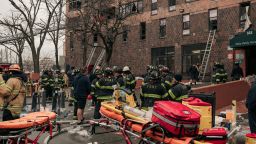Editor’s Note: Yvette Williams MBE is a lead campaigner on the Justice 4 Grenfell campaign. She is a founding member of Operation Black Vote, a national campaign encouraging Britain’s Black and minority ethnic communities to engage in the democratic process. The views expressed in this commentary are her own. View more opinion on CNN.
Watching the news footage of the fatal fire that spread through a New York apartment block Sunday, I was transported back in time to another fire that four years ago changed my life forever.
On June 14, 2017, I watched as flames engulfed Grenfell Tower – a 24-story high-rise block of flats in west London – in the neighborhood I have lived in for more than three decades. I can still remember the smell of burning, onlookers screaming, faces at the windows and people crying for help. The fire killed 72 people. In moments like this, you are left numb, utterly powerless. You question if this nightmare is really happening.

As reports of the Bronx fire came in, I knew that the families and friends of residents in that apartment block, and the local community, would be living the same trauma. They would be holding on to hope that their loved ones survived. And in their shock, they would be questioning how the fire happened.
We don’t yet know the full circumstances of the Bronx fire, yet there are already striking similarities to those at Grenfell. Much like in London, the New York blaze started in one apartment, there was not a functioning fire door and smoke then spread through the stairwell to every floor.
When the fire happened at Grenfell Tower, it turned the spotlight on whether the construction, refurbishment and management of the block, as well as existing building regulations, were adequate, and in particular how external cladding – placed on the building solely for aesthetic purposes – significantly contributed to the speed and spread of the fire. These questions sparked a larger fight for housing equality that is still being fought today.
Other similarities between the London and Bronx fires show race and social class must be part of the conversation about these catastrophes. The New York block contained affordable housing and is located in an area of the Bronx home to a large Muslim and migrant community. Indeed, many of those in the building were immigrants from the West African nation of The Gambia.
Similarly, 85% of the residents who died at Grenfell Tower, a social housing high-rise, were from ethnic minorities. And almost half of the victims were disabled adults or children. No personal emergency evacuation plans were in place for these vulnerable residents. We face social inequality every day of our lives, yet the Grenfell public inquiry has chosen to exclude the issues of class and race from its terms of reference.
But the inquiry did expose a wretched building industry culture in Britain, in which thousands of households across the country are living in fear in their homes. Leaseholders with no prior knowledge of their homes being covered in flammable materials faced huge cost to have it removed. On Monday, Housing Secretary Michael Gove, under increased pressure to act on the cladding crisis, announced new legislation protecting leaseholders from the costs of all post-Grenfell safety defects.
In the UK, the outsourcing of public services over the years diminished accountability and scrutiny, and poor building regulations compounds the problem. The use of flammable materials was hidden in plain sight and an unnecessary cost-cutting exercise by the local authority – one of the richest in Britain. One of the Tenant Management Organisation’s main contractors saved £126,000 (US$171,000) by switching to a cheaper and more dangerous type of cladding for the refurbishment. And former tenants said they were bullied by housing managers into accepting renovations they feared were a safety risk.
In the case of the Bronx fire, investigators are looking into the possibility it was started by a malfunctioning electric heater. The building’s fire alarms and a series of open doors are also on the radar of investigators and officials probing one of the worst fire’s in the city’s history. The bereaved families of the Bronx fire will now be asking similar questions to Grenfell four years ago. Each member of this community will be touched by the loss in their own way; the charred building will be a daily reminder; a once occupied seat in the classroom, a colleague who you no longer see, the person who no longer serves you at the store, drives your bus. It leaves a gaping hole in so many lives of the survivors.
Our fight for justice lies on the foundation that everyone should have a safe and decent home to live in. This should be a right, not a privilege. Your home is supposed to be a haven. The safest place for you and your family. But all too often, the most vulnerable people are given the keys to their home – usually built and maintained to the minimum of standards – and left to it.
There are so many other things authorities must do to keep people informed of how to stay safe in their homes and this should be a wake up call for all managed buildings. At minimum there should be a mandatory component of any tenancy agreement to know what to do if a fire occurs in their home and appropriate fire doors fitted, and this should be supported by regular public information announcements.
Today my heartfelt thoughts and prayers are with the families and friends of the 17 men, women and children who died in the New York fire. We must change our mindset and see these buildings not just as real estate, but as people’s homes. An equitable standard of safety in our homes, whether for the poor or the wealthy, should exist – because all our lives are equally valuable.






